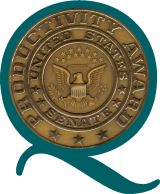Mission
|
Strives to develop the whole person, particularly their ethical values and capacity for life-long learning.
|
Vision
|
Achieves national recognition for quality undergraduate programs and regional recognition for Graduate programs.
|
Hallmark Values (core competencies)
|
Continuous quality improvement, superior teaching, innovation and ethical conduct.
|
Our Culture
|
- Listens to stakeholders and strives to provide student-centered learning; innovative, relevant, quality programs and responsive customer service.
- Characterized by transparency, collaboration and empowerment championed by the faculty/staff and leadership teams.
-
|
SBA
|
part of Marymount University (private, non-profit) Sites: Arlington (main); Reston (satellite)
|
Employees
|
35 (administration, faculty, staff) Non-unionized.
|
Services
|
Undergraduate and Master's level business degrees and certificates.
|
Total SBA Student Enrollment
|
823 students in Fall, 2007
|
|
Faculty/Student Ratio
|
1 to 15
|
Organizational Culture
|
Characterized by transparency, collaboration and empowerment Cf. Figure P.1-2 below
|
Critical Success Factors
|
Academic excellence, Catholic identify and branding; Student Recruitment and Retention
|
Accreditations
|
SACS, ACBSP, ABA, CAHME
|
EXAMPLE: Figure X.x Marymount University wide PDCA System to Avoid Adverse Ethical Impacts
|
Process for Impact Monitoring
|
Description
|
Inputs, Activities, Etc.
|
Measures/Indicators
|
Plan
|
University-wide social responsibility criteria are included in University strategic planning.
|
President and senior leaders, including SBA's, help develop University plan.
|
Publication and discussion of annual strategic plan update.
|
Do
|
University senior leadership monitors the external environment and strategic plan
|
Monitoring by Board of Trustees, President, senior leaders and Chaplain.
|
Board endorsement of University strategic plan. President's report to Board on action plans.
|
Check
|
SWOT and gap analysis is performed on adverse/ unethical impacts.
|
President and senior leaders conduct analysis.
|
Number of potential or actual adverse effects are analyzed.
|
Act
|
Corrective action is taken as needed.
|
President and/or Board orders corrective action
|
Number of actions taken.
|
System Design
|
Plan
|
Do
|
Check
|
Act
|
Key Student Requirements
|
Faculty/staff review needs and satisfaction data.
|
Changes are made to programs or services.
|
Senior leaders, DCD, faculty/staff monitor new process changes.
|
Measures of success are reviewed in strategic planning cycle
|
New Technologies
|
University IT unit plans.
|
SBA inputs new technology needs into annual IT unit budget.
|
University IT unit checks and surveys users. Input from stakeholders/collaborators is solicited.
|
SBA makes requests and proposals to the University IT unit and senior administrators.
|
New Organizational Knowledge
|
Best practices are learned from external sources..
|
Shared governance system makes a consensus decision on proposed changes
|
SBA Senior leaders and workforce do ongoing external environmental scanning.
Voice of the customer feedback and expertise of partners/collaborators is sought.
|
Shared governance system makes a consensus decision on needed actions.
|
Organizational Sustainability
|
Critical success factors, core competencies and strategic initiatives are inputs into planned improvements.
|
Shared governance system vets any proposed changes against critical success factors, core competencies and strategic initiatives
|
Organizational culture operates to monitor changes.
|
Transparency, collaboration and empowerment of the culture enables agile response.
|
|
Identified Success Factor
|
Description
|
Competitive Organizations
|
Academic Excellence
|
- 100% professionally or doctorally qualified faculty.
- Teaching oriented mission.
- Small classes with student-centered learning philosophy and accessible faculty.
|
- Closely comparable
- Research orientation.
- Large lecture orientation with substantial use of teaching assistants and/or adjunct faculty.
|
Catholic Identity and Branding
|
- Cultural association of Catholic education with "quality education."
- Achievement of SPQA external validation via Certificate for Commitment to Continuous Improvement (2007).
- Focus on teaching ethics; Center for Ethical Concerns.
|
- Only 2 competitors are religiously affiliated.
- No other Virginia college has achieved any SPQA recognition. Other schools just moving in this direction.
|
Student Recruitment and Retention Systems
|
- A University-wide student retention process has been deployed. It includes University promotion of student life and major capital investment in facilities and technology.
- SBA has an effective assigned faculty advising system.
|
- Closely comparable.
- Generic student tutorial help.
- Less individualized or non-faculty advisors.
|

